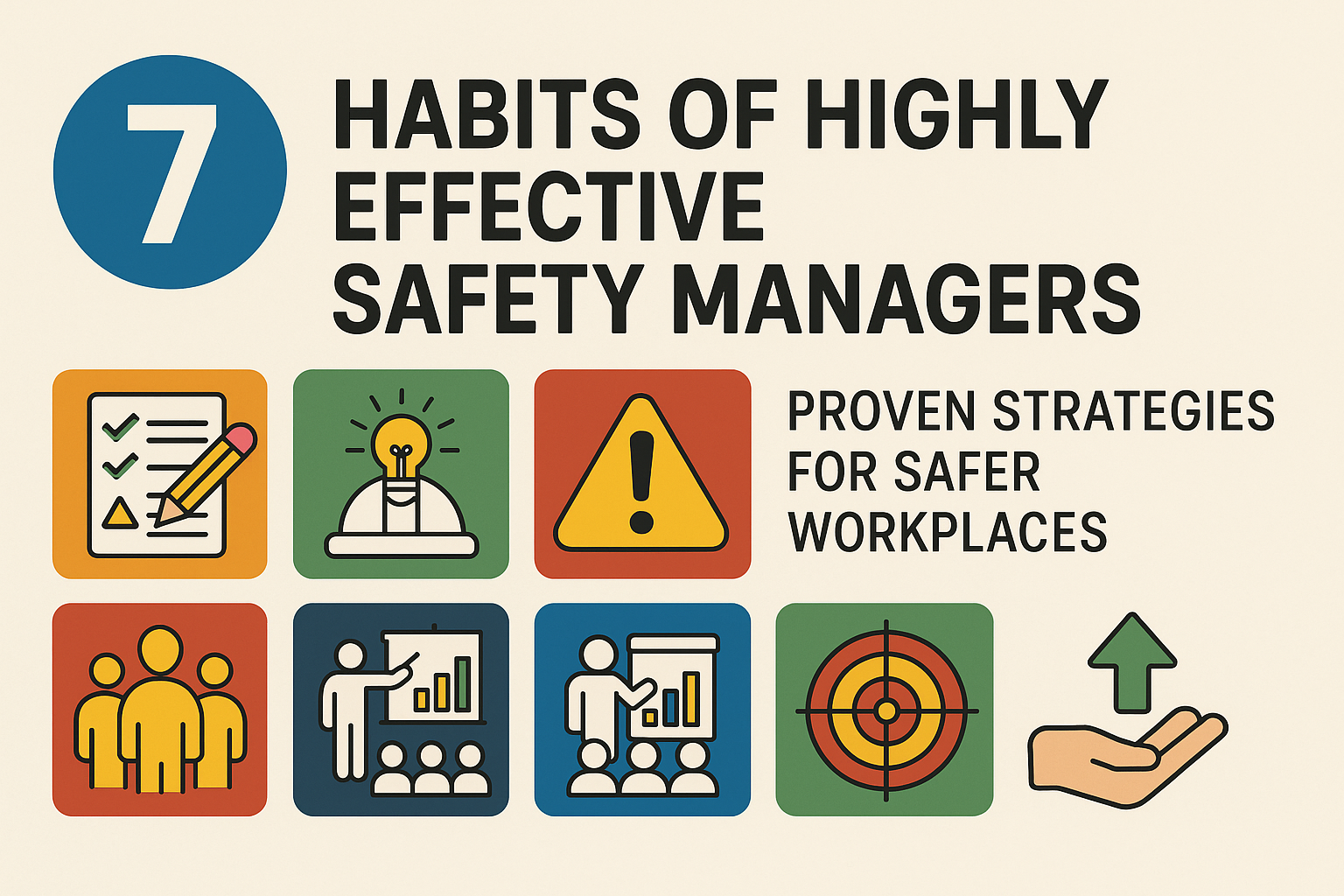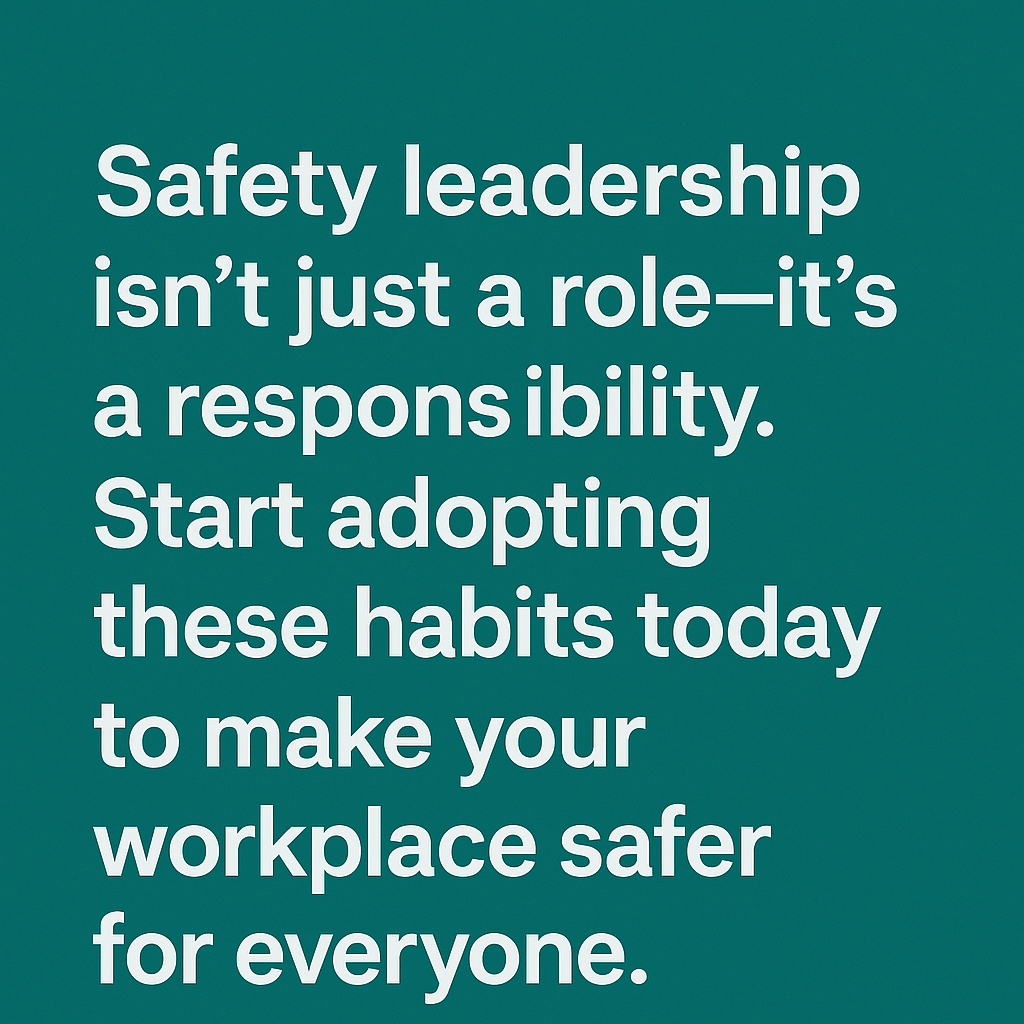Highly Effective Safety Managers don’t just enforce rules—they inspire teams, reduce risks, and build lasting safety cultures. At the beginning of any serious safety program, leadership is the cornerstone of success.

Whether you’re an experienced safety professional or just stepping into a leadership role, adopting these 7 Habits of Highly Effective Safety Managers will help you guide your team toward fewer injuries, better compliance, and stronger morale.
- Why Safety Leadership Matters
- ✅ 1. Prioritize Active Listening
- ✅ 2. Lead by Example
- ✅ 3. Communicate Clearly and Consistently
- ✅ 4. Focus on Positive Reinforcement
- ✅ 5. Stay Data-Driven
- ✅ 6. Champion Continuous Improvement
- ✅ 7. Empower and Involve Employees
- Implementing the 7 Habits in Your Workplace
- Benefits of Highly Effective Safety Managers
- Final Thoughts on Highly Effective Safety Managers
Why Safety Leadership Matters
It’s easy to think of safety as a set of policies and procedures—but in reality, people make workplaces safe.
A Highly Effective Safety Manager understands that leadership is about influencing attitudes and behaviors:
- Building trust with workers
- Promoting open communication
- Modeling the behaviors you want to see
OSHA (DoFollow) emphasizes that strong safety leadership is a critical element of any effective safety and health program.
✅ 1. Prioritize Active Listening
Highly Effective Safety Managers make listening their superpower.
They don’t just lecture about rules—they invite workers to share concerns, ideas, and experiences. Active listening helps you:
- Identify real, frontline hazards
- Uncover cultural barriers to safe behavior
- Build trust with your team
Practical tips:
- Ask open-ended questions
- Avoid interrupting
- Summarize what you heard to confirm understanding
When workers feel heard, they’re far more likely to follow safety procedures and participate in solutions.
✅ 2. Lead by Example
Safety leaders can’t say one thing and do another. Highly Effective Safety Managers model the behaviors they expect from others.
Examples:
- Always wearing required PPE
- Following lockout/tagout procedures even when it’s inconvenient
- Participating in safety meetings as an engaged learner, not just a supervisor
Workers watch what you do, not just what you say. Your actions set the tone for the entire safety culture.
✅ 3. Communicate Clearly and Consistently
Highly Effective Safety Managers are great communicators. They know safety messaging can’t be complicated or inconsistent.
Key strategies:
- Use simple, direct language
- Repeat core messages regularly
- Tailor communication to your audience (e.g., multilingual materials if needed)
- Provide context—explain why rules matter
Use multiple channels, from toolbox talks to posters and digital alerts. For more on communication strategies, see our article on Training and Safety Awareness.
✅ 4. Focus on Positive Reinforcement
While discipline is part of the job, Highly Effective Safety Managers understand that positive reinforcement is even more powerful.
Rather than only punishing unsafe behaviors, they:
- Recognize and praise safe work
- Celebrate safety milestones
- Offer incentives for proactive hazard reporting
Positive feedback encourages repeat safe behavior and shows workers that safety is genuinely valued, not just enforced.
✅ 5. Stay Data-Driven
Effective safety managers make decisions based on facts, not guesswork.
They track and analyze safety data, such as:
- Incident and near-miss reports
- Audit and inspection results
- Training attendance and testing
- Behavioral observations
Data helps identify trends, prioritize risks, and measure program effectiveness.
Tools like NIOSH’s Hierarchy of Controls (DoFollow) help managers plan effective interventions.
✅ 6. Champion Continuous Improvement
Highly Effective Safety Managers know safety isn’t a static goal—it’s an ongoing process.
They regularly:
- Review procedures and policies
- Conduct inspections and audits
- Update training content
- Analyze incidents for root causes
They also encourage worker suggestions and implement improvements when feasible.
Continuous improvement keeps your safety program dynamic and effective in the face of changing hazards and work processes.
✅ 7. Empower and Involve Employees
Safety is everyone’s responsibility, but it’s the manager’s job to make workers feel empowered to participate.
Highly Effective Safety Managers:
- Include workers in risk assessments
- Encourage hazard reporting without fear of reprisal
- Support active safety committees
- Provide meaningful roles in safety meetings and planning
When employees have ownership, they’re more likely to follow procedures and help enforce them among peers.
For more on involving employees, check out our guide on Behavior-Based Safety: Does It Really Work?.
Implementing the 7 Habits in Your Workplace
If you’re wondering how to get started adopting these 7 Habits of Highly Effective Safety Managers, try this approach:
1️⃣ Self-assessment: Which habits do you already practice? Where do you need improvement?
2️⃣ Goal-setting: Choose one or two habits to focus on first.
3️⃣ Team involvement: Let your team know your goals and ask for feedback.
4️⃣ Measure progress: Track improvements in communication, reporting, and safety metrics.
5️⃣ Celebrate wins: Recognize both your growth and your team’s efforts.
Remember, no one becomes a perfect safety leader overnight. It’s about consistent, intentional effort.
Benefits of Highly Effective Safety Managers
When safety managers adopt these 7 habits, the whole workplace benefits:
- Reduced incident rates
- Higher worker morale and retention
- Improved regulatory compliance
- Lower insurance costs
- Stronger reputation as a safe employer
Investing in leadership development pays dividends across all these areas.
Final Thoughts on Highly Effective Safety Managers
Highly Effective Safety Managers don’t rely on rules alone—they build trust, communicate clearly, and inspire teams to care about safety as much as they do.
By practicing these 7 Habits of Highly Effective Safety Managers, you’ll foster a resilient safety culture, reduce risks, and demonstrate true leadership in protecting your people.


No comments yet